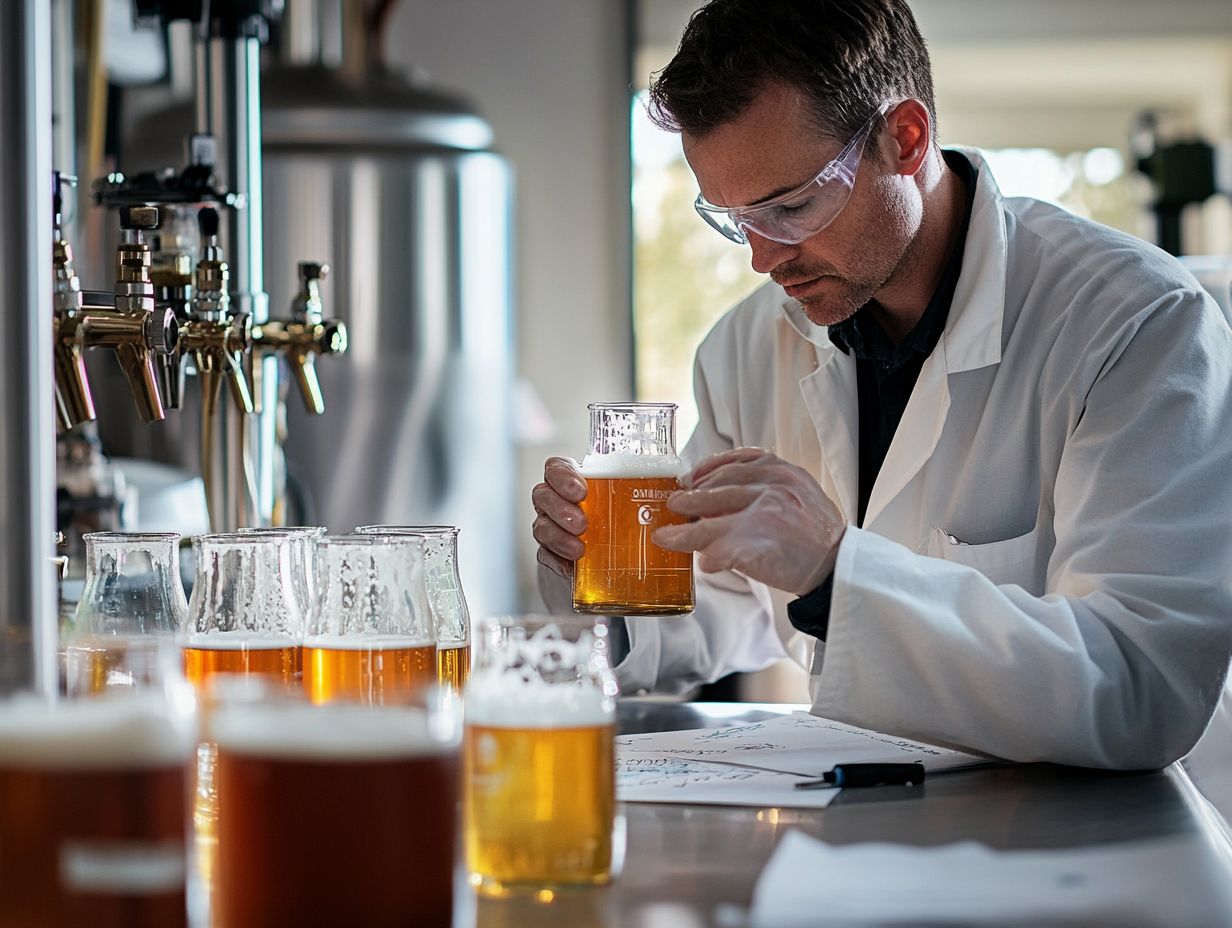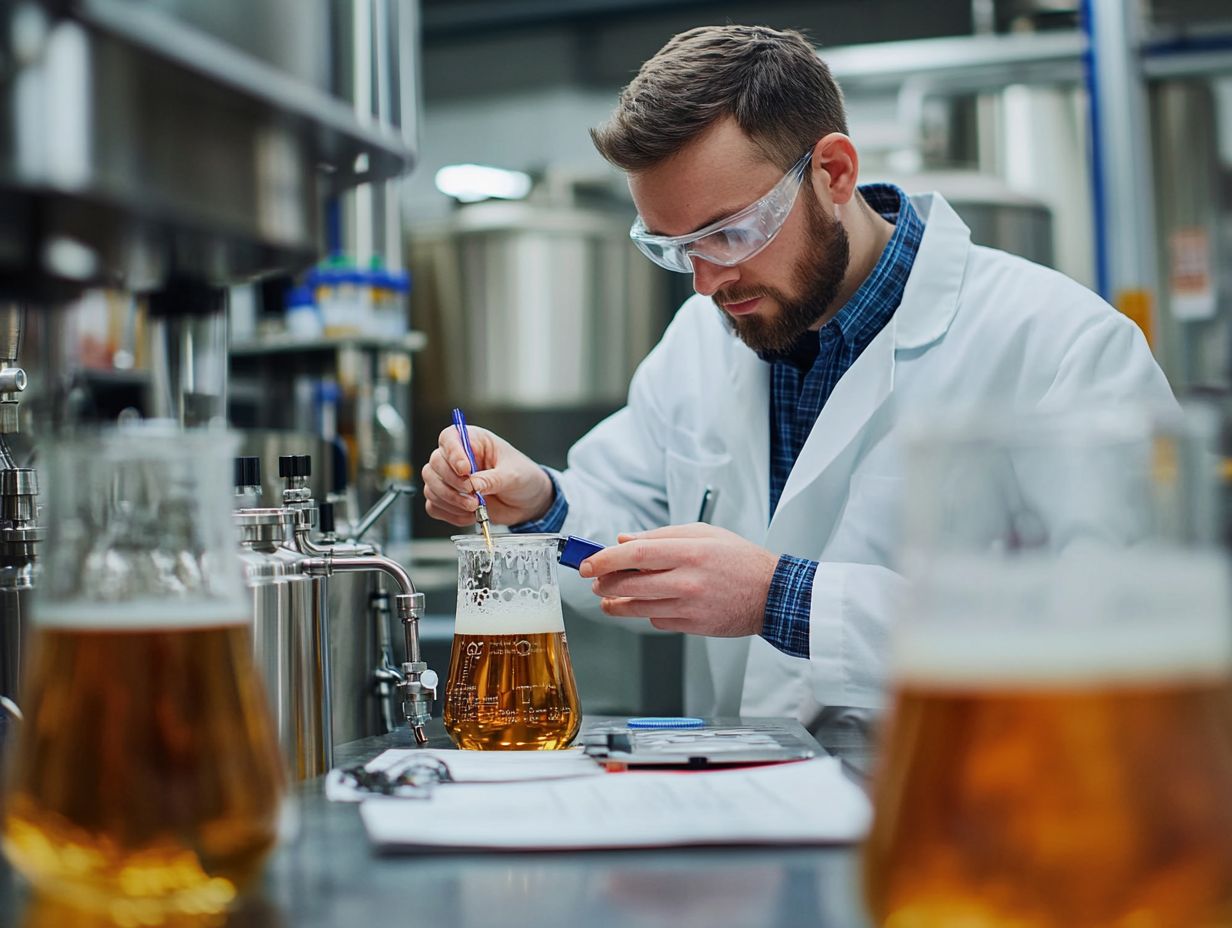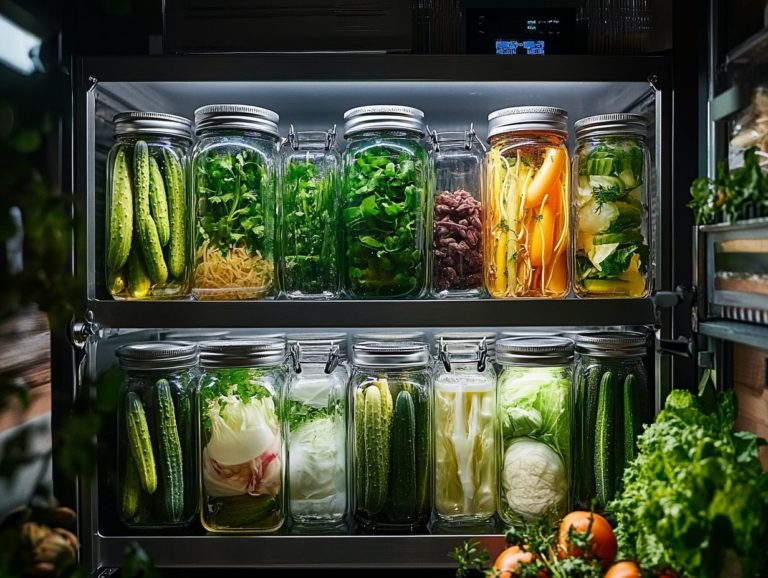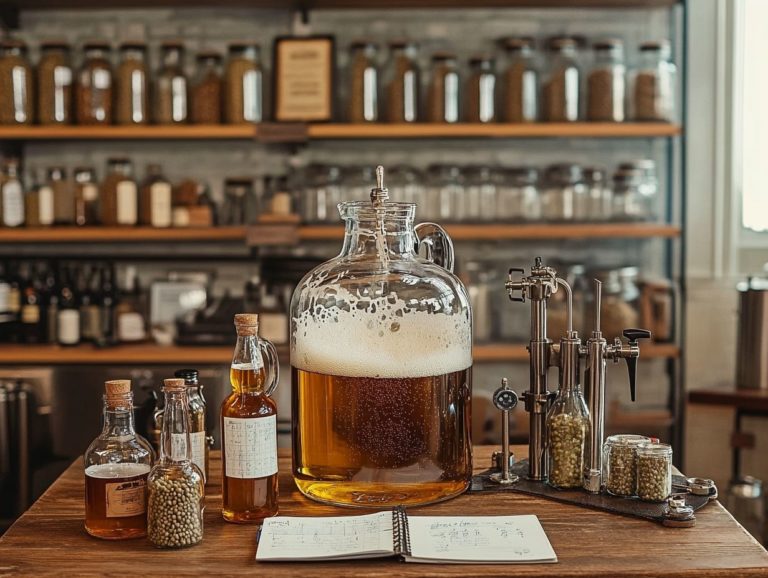The Impact of pH on Beer Fermentation
Beer fermentation is an intriguing process that turns basic ingredients like malt, hops, and water into a rich and flavorful beverage.
For you, understanding the various factors that influence fermentation is essential if you re striving to create the perfect brew. Among these factors, pH stands out as a crucial element, impacting yeast activity, flavor profiles, and the overall quality of your beer while also influencing the acidity levels and stability of your brewing process.
Get ready to dive into the exciting world of beer fermentation! This article delves into the complexities of beer fermentation, shining a light on key aspects such as yeast strains, temperature, nutrient availability, and the use of enzymes, while offering guidance on how to measure and adjust pH for the best results.
Whether you re a seasoned brewer or just beginning your journey, you ll uncover valuable insights to elevate your brewing process and improve the clarity and stability of your final product.
Contents
- Key Takeaways:
- What Is Beer Fermentation?
- What Are the Main Factors Affecting Beer Fermentation?
- 2. Temperature
- 3. Oxygen Levels
- 4. Nutrient Availability
- What Is pH and How Does It Affect Beer Fermentation?
- How to Measure and Adjust pH for Beer Fermentation?
- What Are the Common pH Problems in Beer Fermentation?
- How Can Brewers Control pH for Optimal Beer Fermentation?
- Frequently Asked Questions
- What is the impact of pH on beer fermentation?
- How does pH affect the flavor of beer?
- What happens if the pH is too high during beer fermentation?
- Can the pH of water used in brewing affect the fermentation process?
- How can I control the pH during beer fermentation?
- What is the ideal pH for beer fermentation?
Key Takeaways:

- pH is a crucial factor in beer fermentation, affecting yeast activity, enzyme function, and flavor. The ideal pH range for fermentation is between 4.2-4.6.
- High or low pH levels can result in off-flavors, unstable acidity levels, and inconsistent fermentation. Brewers can measure and adjust pH using specialized tools and methods.
- Controlling pH is essential for achieving optimal beer fermentation. Factors such as yeast strains, temperature, oxygen levels, nutrient availability, and chemical balance should also be considered for successful fermentation.
What Is Beer Fermentation?
Beer fermentation is an essential aspect of brewing that transforms the sugars derived from malt into alcohol and carbon dioxide. This process is influenced by a variety of factors, including the strains of yeast used, temperature fluctuations, and pH levels.
The intricacies of fermentation not only dictate the alcohol content of the final product but also have a profound impact on its flavor, aroma, and overall quality. With the yeast working its magic alongside a diverse microbial community, fermentation becomes pivotal in crafting unique characteristics. It ensures stability and maintains the clarity and acidity of the beer.
Thus, understanding and mastering this process is crucial for anyone looking to elevate their brewing experience and create exceptional beverages.
What Are the Main Factors Affecting Beer Fermentation?
Several critical factors influence your beer fermentation process, including yeast strains, temperature, oxygen levels, and nutrient availability. Each of these elements plays a distinct role in determining the efficiency, quality, and clarity of your final product.
The yeast strain you choose can significantly impact both flavor profiles and fermentation rates. Maintaining an optimal temperature is essential for preserving the health and performance of the yeast. Monitoring oxygen levels is vital to prevent unwanted microbial growth.
Ensuring adequate nutrient availability enables the yeast to carry out fermentation effectively. All of these factors contribute to the overall success of your brewing endeavor.
1. Yeast Strains
Yeast strains play a pivotal role in the fermentation process, directly shaping the flavors, aromas, and alcohol content of the beer you enjoy. Each yeast strain, whether it s Saccharomyces cerevisiae or Saccharomyces pastorianus, brings its own unique flair to the final product, presenting a delightful spectrum of profiles that range from fruity and estery to clean and crisp.
Thus, selecting the right yeast strain is a vital decision for you as a brewer. It influences not only fermentation efficiency but also the distinctive flavors and overall quality of your beer.
Take Ale yeast (Saccharomyces cerevisiae), for example. It thrives in warmer fermentation conditions and can conjure a vibrant array of flavor notes, from banana to clove, making it perfect for styles like hefeweizen and pale ales. On the flip side, Lager yeast (Saccharomyces pastorianus) prefers cooler temperatures, resulting in a smoother, crisper finish that characterizes popular lagers and pilsners.
Then there are specialty strains, such as Brettanomyces and various wild yeast types, which can introduce complexity through funk and tartness, especially in sour beers. Each of these strains serves as a fundamental building block in your brewing journey, enabling an endless array of variations in taste and style.
By mastering fermentation, you not only enhance the taste of your beer but also your brewing skills. Cheers to brewing greatness!
Now that you re equipped with these insights, why not experiment with your own brew? You might just discover your next favorite flavor!
2. Temperature
Temperature plays a crucial role in the fermentation of beer, influencing yeast activity and the rate of fermentation. By maintaining the right fermentation temperature, you ensure that the yeast operates at its best, efficiently converting sugars while minimizing unwanted off-flavors and fusel alcohols.
This also ensures the clarity of your brew. Every beer style has a specific temperature range, making temperature control a fundamental aspect of the brewing process that directly impacts flavor, stability, and overall quality.
You ll find that different strains of yeast respond uniquely to temperature changes, affecting not just the speed of fermentation but also the aromatic and flavor profiles that develop. For example, lager yeasts thrive at lower temperatures, resulting in crisp, clean flavors. In contrast, ale yeasts flourish in warmer conditions, allowing fruity or spicy notes to come forth.
As a brewer, staying vigilant is essential. Regularly monitoring the fermentation environment allows you to make any necessary adjustments. A stable fermentation temperature nurtures a healthy yeast population and enhances the beer’s character, ensuring that the final brew aligns with your desired tasting notes and characteristics.
3. Oxygen Levels
Oxygen levels during fermentation are pivotal for the health of your microbial community and the quality of the beer you produce. While your yeast requires a touch of oxygen for initial growth, too much exposure can trigger unwanted oxidation, resulting in off-flavors and spoilage.
This is why managing oxygen levels is essential in brewing; it allows your yeast to thrive without jeopardizing the stability and flavor integrity of your final product. To achieve this delicate balance, you need to adopt various techniques to monitor and control oxygen exposure.
Employing methods such as purging fermentation vessels with carbon dioxide before filling or using substances that absorb oxygen ensures that your yeast can access the necessary oxygen without risking excess levels. Using closed-transfer systems during kegging or bottling can significantly reduce contact with air, providing extra protection against oxidation.
By implementing these strategies, you can create a controlled environment that nurtures the fermentation process, leading to a vibrant and flavorful beer while minimizing the risks associated with both low and high oxygen levels.
4. Nutrient Availability

Nutrient availability is an essential component of beer fermentation that directly influences your yeast’s performance and fermentation efficiency. To thrive and effectively carry out fermentation, yeast requires a variety of nutrients, including nitrogen, vitamins, and minerals.
When nutrient levels are insufficient, you risk encountering sluggish fermentation or, worse yet, complete fermentation failure. This can lead to a less-than-stellar final product. As a brewer, ensuring nutrient levels is vital to a successful brew!
Among the critical nutrients, nitrogen plays a vital role, as yeast converts it into amino acids necessary for growth and metabolism. Essential vitamins like biotin and pantothenic acid support the enzymatic reactions crucial for energy production.
Minerals such as phosphorus and magnesium enhance yeast performance by stabilizing cell membranes and aiding in DNA synthesis. To maintain the adequacy of these nutrients, you can implement strategies such as using yeast nutrient blends or adding specifically designed nutrient additions during fermentation.
By monitoring the fermentation stages, you can promptly adjust nutrient levels, ensuring a vigorous yeast population that efficiently converts sugars to alcohol. This proactive approach ultimately improves the quality, clarity, and stability of your beer.
What Is pH and How Does It Affect Beer Fermentation?
pH plays an important role in beer fermentation, directly impacting the acidity of the wort (the liquid extracted from the mash during the brewing process) and the overall flavor profile of the finished product. The pH level you maintain influences yeast activity and enzyme function, as well as the stability and biochemical reactions throughout fermentation. These factors ultimately define the characteristics of your beer.
Striving for an optimal pH range promotes yeast health and stability. It also ensures that your brew remains consistent and flavorful. Neglecting pH management can lead to flavor defects, instability, and diminished fermentation efficiency. Therefore, mastering pH management is crucial for your brewing success. It involves careful measurement and adjustment techniques.
What Is the Ideal pH Range for Beer Fermentation? Understanding the balance between acidity and alkalinity is key to maintaining the stability and flavor profile of your beer.
The ideal pH range for your beer fermentation typically falls between 4.0 and 5.5. This range depends on the style you re aiming for and the fermentation process you choose. Within this range, yeast operates at its peak efficiency, promoting healthy fermentation while minimizing the risk of off-flavors and spoilage. Keeping the right pH balance is essential for achieving the flavor profile and overall quality you desire, making it a top priority during the fermentation phase.
For example, if you re brewing lagers, they tend to ferment optimally at a pH closer to 5.0. This supports a clean and crisp flavor. In contrast, certain ales may thrive at slightly lower pH levels to enhance their delightful fruity notes.
However, if the pH strays from these optimal levels, you could encounter several issues. Overly acidic conditions can inhibit yeast activity, leading to the production of undesirable sulfur compounds. On the other hand, excessively alkaline environments might encourage bacterial growth, ultimately jeopardizing the integrity of your brew.
Understanding and managing pH is crucial for anyone looking to craft consistent, high-quality beers that genuinely reflect the intended style.
How Does pH Affect Yeast Activity During Fermentation?
pH levels are crucial in shaping yeast activity during beer fermentation. They can either boost or hinder yeast growth and fermentation efficiency. Maintaining a balanced pH level promotes optimal enzyme function, enabling yeast to efficiently transform sugars into alcohol and carbon dioxide. Extreme pH levels can stress yeast, resulting in sluggish fermentation, off-putting flavors, and even fermentation failures. This shows why monitoring pH during brewing is essential.
The biochemical processes involved are quite intricate. Specific pH levels activate different enzymatic pathways, influencing how yeast metabolizes various sugars. For example, an acidic environment might encourage the production of certain esters and phenols, adding distinctive flavor profiles to your final brew. Conversely, a high pH can lead to the emergence of off-flavors like diacetyl, which are generally less desirable.
Variations in pH can also affect the solubility of hops and other ingredients, further shaping the overall sensory experience of the beer. Therefore, understanding and managing pH is vital for brewers who aspire to optimize fermentation and achieve their preferred flavor characteristics.
What Are the Effects of High and Low pH on Beer Flavor?
Both high and low pH levels can profoundly affect the flavor of your beer, potentially leading to undesirable characteristics and instability in the final product.
For instance, if your beer has a pH above 5.5, you may notice off-flavors reminiscent of cardboard or paper, particularly affecting lighter styles like pilsners and wheat beers. These styles rely on a crisp mouthfeel. Conversely, darker ales such as stouts can sometimes thrive with lower pH levels, enhancing the roasted malt notes. However, excessive acidity can overshadow the intended flavor profile.
To manage pH effectively, you can employ tools like acidic adjuncts or minerals such as gypsum to fine-tune your brewing water chemistry. This way, you’ll ensure that your final product maintains its intended flavor integrity while appealing to a diverse range of palates.
How to Measure and Adjust pH for Beer Fermentation?
Measuring and adjusting pH during beer fermentation is an essential aspect of the brewing process, as it ensures that the wort remains within the best levels for yeast activity and flavor development.
You have access to several tools for precise pH measurement, such as pH meters and test strips, allowing you to monitor pH levels throughout the fermentation journey.
When adjustments are needed, you can employ various methods to fine-tune the acidity, tailoring it to the desired beer profile and ensuring a high-quality final products that truly stand out.
What Tools Are Needed for Measuring pH?
To measure pH accurately in beer fermentation, you ll typically turn to tools like pH meters and test strips. Each brings its own set of advantages in assessing acidity levels. A pH meter offers precise measurements and is perfect for regular monitoring throughout the brewing process.
On the other hand, test strips provide a more accessible, though less precise, option for quick checks. Your choice of tool will depend on your needs, budget, and the level of accuracy you seek for optimal fermentation.
Understanding the features and limitations of these measurement tools is crucial for ensuring the quality of your brew. pH meters, equipped with advanced calibration processes, deliver reliable and consistent results, making them ideal for those who uphold rigorous brewing standards.
However, they do require regular calibration and may come with a higher initial investment. Conversely, pH test strips are user-friendly and budget-friendly, but their lack of precision might lead to suboptimal acidity adjustments.
To make the most of either tool, it s best practice to maintain clean probes for the meters and ensure proper storage of the strips. By doing so, you can optimize your fermentation processes and elevate the quality of your brew.
What Are the Methods for Adjusting pH?

You have several effective methods at your disposal for adjusting pH levels during beer fermentation. These methods allow you to achieve the desired acidity for optimal yeast performance.
Common approaches include adding acids, such as lactic acid or phosphoric acid, to lower the pH, or employing basic substances that can raise pH, like sodium bicarbonate. Each method comes with its own considerations, and grasping the chemistry behind these adjustments is essential for finding the perfect balance in your brewing process.
When selecting a pH adjustment method, reflect on the specific style of beer you re crafting. Different styles often demand varying acidity levels to enhance both flavor profiles and yeast activity.
For example, a lager may thrive in a lower pH environment, while certain ales could benefit from a slightly higher pH. It s crucial to monitor the potential for over-acidification or excessive alkalinity when employing these methods, as they can lead to undesirable flavors or off-aromas.
By skillfully balancing these factors, you can create a beverage that not only meets technical specifications but also delivers exceptional taste and character.
What Are the Common pH Problems in Beer Fermentation?
You may encounter common pH challenges during beer fermentation, such as elevated pH, lowered pH, and fluctuations that can negatively impact yeast activity and the overall quality of your brew.
High pH levels often result in an undesirable flatness of flavor, while low pH can introduce unwelcome sour notes both factors that can compromise your brewing process.
Fluctuating pH levels create instability, hindering yeast from performing at its best. You must tackle these issues directly to achieve the best results if you’re striving for consistency and excellence in your final product.
1. High or Low pH Levels
High or low pH levels during beer fermentation can significantly impact the flavor, stability, and overall quality of your final product. A high pH can lead to stale, flat flavors. In contrast, a low pH might introduce an unwanted sourness both of which are detrimental to the brewing process.
Understanding these extremes and their effects on yeast activity is crucial for you as a brewer aiming to produce high-quality beer. For example, a high pH level above 5.6 can negatively affect styles like pale ales, resulting in a dull, lifeless taste that lacks character.
On the flip side, low pH levels, particularly below 4.0, may enhance sour beers or lambics, but they could ruin a carefully crafted lager, leading to excessive tartness that overshadows the intended flavors. To maintain optimal fermentation conditions, regularly monitor your wort’s pH using pH meters or strips.
Adjust the pH with food-grade acids or alkalizing agents as needed. This proactive approach not only secures the desired flavor profiles but also fosters a consistent and enjoyable drinking experience.
2. Fluctuating pH Levels
Fluctuating pH levels during fermentation can pose significant challenges for you as a brewer. These fluctuations can lead to instability in the yeast population and undesirable off-flavors in your final product. Various factors, such as the addition of ingredients or alterations in fermentation conditions, can cause these fluctuations.
Consistent pH levels are vital for ensuring yeast health and achieving the flavor profile you desire. These pH shifts can directly impact yeast fermentation, causing fermentation rates to lag and affecting sugar conversion.
Since the yeast’s ability to metabolize sugars is heavily influenced by the surrounding pH, extreme variations can result in inefficient alcohol production and inconsistent sensory attributes. To tackle these challenges, implement regular pH monitoring and make necessary adjustments.
Utilizing buffer solutions, such as phosphates or citrates, can effectively help stabilize pH levels. Proper sanitization techniques and strict ingredient quality control can minimize unwanted microbial activity, which could further contribute to fluctuations.
3. Inconsistent pH Readings
Inconsistent pH readings during beer fermentation can create uncertainty in your brewing process. This uncertainty can compromise the quality of your final product. Calibration errors can cause these discrepancies, along with various environmental factors impacting your readings.
For you, accurate and consistent pH measurement is essential for maintaining control over fermentation conditions and ensuring the stability and flavor integrity of your beer. Common culprits behind these inconsistencies can include dissolved solids in the fermentation vessel, which may skew your readings.
Temperature fluctuations can also alter the pH of the solution. Regularly calibrate your pH meters with high-quality buffer solutions and ensure that your measuring equipment is well-maintained. Adopting standard sampling practices, such as taking readings at consistent stages of fermentation, can greatly help in mitigating discrepancies.
Regularly cleaning your equipment preserves measurement accuracy and fosters a hygienic brewing environment, ultimately enhancing the overall quality and consistency of your final product.
How Can Brewers Control pH for Optimal Beer Fermentation?
You can control pH for optimal beer fermentation through various techniques and adjustments. This ensures that your yeast remains healthy and active throughout the brewing process. By grasping the influences of pH on fermentation and flavor development, you can implement specific strategies.
Strategies include meticulous ingredient selection, precise pH measurement, and targeted adjustments to achieve your desired acidity levels. This level of control is critical for crafting high-quality beer that exceeds consumer expectations for flavor and consistency.
Frequently Asked Questions
What is the impact of pH on beer fermentation?
The pH of the brewing environment significantly impacts beer fermentation. It influences yeast growth and activity, which are essential for converting sugars into alcohol and carbon dioxide.
How does pH affect the flavor of beer?
The pH level greatly influences beer’s flavor. A lower pH results in a tart and sour taste, while a higher pH leads to a smoother, sweeter flavor. Different beer styles require specific pH levels for their flavor profiles.
What happens if the pH is too high during beer fermentation?
If pH levels are too high during fermentation, yeast growth and activity decrease. This results in slower fermentation, producing weaker and less carbonated beer. It can lead to off-flavors and spoilage.
Can the pH of water used in brewing affect the fermentation process?
Yes, the pH of brewing water significantly impacts fermentation. Higher pH water can raise the final beer pH, resulting in less acidity and a potentially sweeter taste. This also affects yeast efficiency and sugar extraction during mashing.
How can I control the pH during beer fermentation?
You can control the pH during fermentation by using acid or alkaline additives, adjusting water mineral content, and closely monitoring pH levels throughout the process. Maintaining a stable pH is crucial for optimal fermentation and flavor development.
What is the ideal pH for beer fermentation?
The ideal pH for fermentation varies by beer style. Generally, a range of 4.2 to 4.8 is recommended for most styles. Some specialty beers may require different pH ranges for the best fermentation and flavor.







